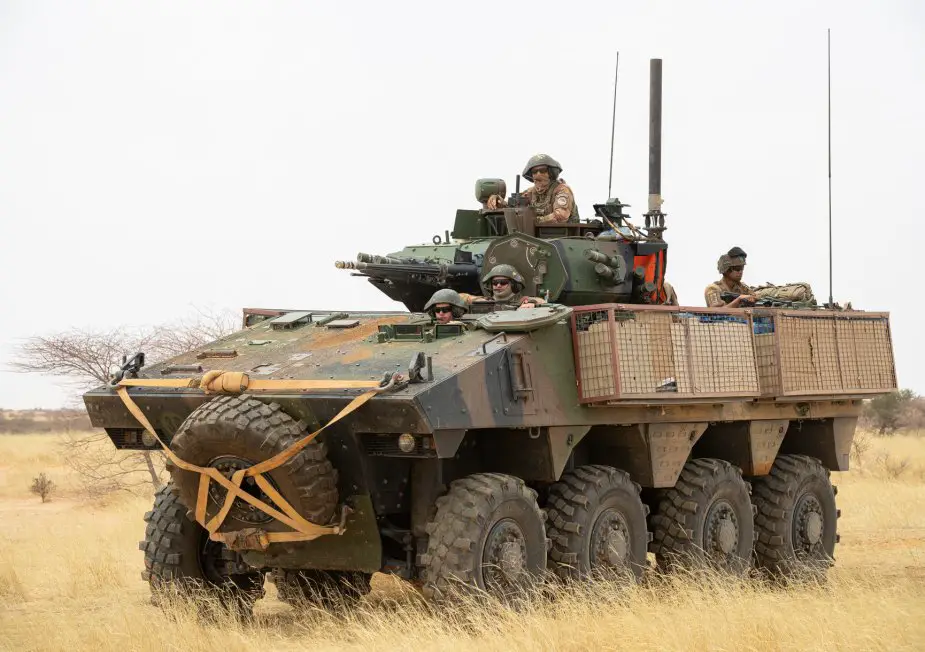From 3 to 23 March, the Barkhane force, together with the Armed Forces of Mali (FAMa) and Niger (FAN), conducted the Monclar operation in the Tri-border area. This engagement, unprecedented in terms of the volume of forces involved, produced very significant results, resulting in the neutralization of a large number of terrorists and the destruction or seizure of a large number of military assets.

VBCI of the French Barkhane force (Picture source: French MoD)
This operation, in which Barkhane committed its land and air assets, was part of a broader action carried out with the joint force of the G5-Sahel (FC-G5S) and the Niger armed forces (FAN), making it possible to achieve a remarkable level of coordination between these different actors in the security of the Sahel. This unprecedented concentration of efforts, involving nearly 5,000 soldiers, follows the numerous operations conducted for several months now in the area of the three borders and is a direct expression of the desire of the Barkhane force, the FC-G5S and partner armies to exert strong pressure against terrorist armed groups, particularly the Islamic State in the Great Sahara (EIGS). These operations have thus concretized the efforts to synchronize the plans desired since the Pau summit, allowing for an unprecedented level of coordination between the forces operating in the region.
An unprecedented commitment
This unprecedented joint commitment illustrates the increase in the strength of partner forces in recent months. Indeed, in particularly trying climatic conditions, 1,700 soldiers of the Barkhane Force, 1,500 soldiers and airmen of the CF-G5S and 1,500 soldiers of the Nigerien armed forces were thus jointly engaged in operations with coordinated objectives, from their own holdings or deployed on the ground, all contributing to the weakening of terrorist armed groups (TAGs) in the area of the three borders.
In addition, Malian and Nigerien forces operated jointly with the Barkhane force in the framework of the Monclar operation, notably in the Nigerien Liptako and the Malian Gourma, while the Barkhane force deployed nearly 400 armored vehicles on the ground during this operation. At the same time, the ANSF also conducted a major operation on its territory, coordinated with the Barkhane Force and the FC-G5S. Finally, the joint force conducted a major operation on the Malo-Burkinabe border.
In total, these operations of unprecedented scale mobilized nearly 5,000 soldiers in the area of the three borders.
Effective coordination through the joint command mechanism
The establishment of the Joint Command Mechanism (JCM), a novel structure consisting of the CF-G5S Liaison Detachment, deployed within the Joint Theatre Command Post (JTCP) from Barkhane to N'Djamena, an Intelligence Sharing Cell and a Joint Command Post (JCP), made it possible to conduct such an operation successfully.
The PCC, which was fully operational, made it possible to coordinate on the ground all the actions of the various units belonging to it in order to maximise the effects of the operation.
The intelligence-sharing cell, for its part, made it possible to deliver intelligence for action which, exploited in a particularly rapid cycle, made it possible to conduct several operations against the TAGs. Thus, from 4 to 5 March, a joint action led by Barkhane and the FAN, combining air assets and the deployment of ground commandos, was carried out on the basis of intelligence from the Niger armed forces. The same was true of the air operations conducted on 5 and 21 March in northern Burkina Faso on the basis of Malian intelligence. These three engagements led to the neutralization of several terrorists.
The results were particularly noteworthy
In the end, in nearly three weeks of operation, the Barkhane force and the Malian and Nigerien forces operating jointly in the Monclar operation neutralized a large number of terrorists. Also, a large number of assets were seized or destroyed, including nearly 80 motorcycles, a technical pickup truck armed with a heavy machine gun, a very large quantity of weapons, ammunition, equipment needed to make explosive devices, and war material of all kinds. For their part, the CF-G5S and the armed forces of the partner countries, which operated completely autonomously and in coordination with Barkhane, also dealt blows to the terrorists.
These numerous tactical successes have degraded the logistical and combat capabilities of armed terrorist groups in the tri-border area, to the benefit of local populations. Well beyond the tactical successes achieved, it is more the level of coordination and synchronisation of operations between the two Sahelian forces, FCG5S and Barkhane, which was achieved and demonstrated during this phase, which augurs well for significant operational progress in the tri-border area.














